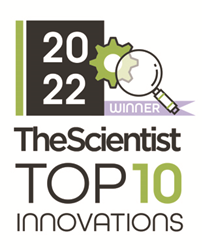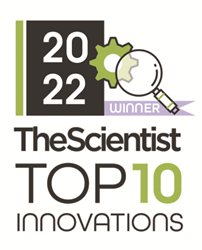
The Scientist Top 10 Innovations
The Scientist is a publication for life science professionals that is dedicated to covering a wide range of biological fields.
WILMINGTON, Del. (PRWEB)
December 16, 2022
Each year The Scientist highlights the latest and greatest tools, technologies, and techniques to hit the life science landscape. For more than a decade, we’ve been employing the assistance of expert panels of independent judges who weigh submissions of innovative products that are speeding work in laboratories and facilitating biological discovery.
This year’s crop of entries to The Scientist’s Top 10 Innovations contest included many with a clinical focus, and others that represent significant advances in sequencing, single-cell analysis, and more. The winners that emerged reflect the fact that the research enterprise continues to hum along as the world emerges from the worst that SARS-CoV-2 threw at us.
The winners of The Scientist’s Top 10 Innovations of 2022 contest are:
1. NeXT PersonalTM (Personalis): A personalized assay that detects, quantifies, and monitors circulating tumor DNA in order to spot molecular residual disease following surgical removal and track responses to therapy
2. CosMxTM Spatial Molecular Imager (NanoString Technologies): A product that visualizes and quantifies RNA and protein levels at the single-cell and even subcellular levels, and allows researchers to image multiple targets in one sample
3. UG100TM (Ultima Genomics): Technology that can sequence an entire human genome for US$100, and also boasts higher speed, better efficiency, and less waste than other sequencers, according to the company
4. ProteographTM Product Suite (Seer): A nanoparticle-based assay that allows unbiased sampling of all peptides in a biofluid sample, allowing researchers to track small molecular changes associated with disease and enabling the identification of novel and biologically relevant proteoforms
5. Live T Cell Assay (Nanolive): An application-specific digital assay that examines how T cells locate, bind, stress, and kill their targets, such as infected, foreign, or cancerous cells
6. MARS® Bar (Applied Cells, Inc.): A closed system that selects cells based on the presence of specific cell surface antigens and is not limited to use in a clean room or biosafety cabinet
7. Single Cellome™ System SS2000 (Yokogawa Electric Corporation): An automated subcellular sampling system that contains both a dual spinning-disk confocal microscope to visualize tissues and a sampling setup to collect either whole cells or intracellular components from a single cell
8. LightBench® Detect (Yourgene Health): A DNA processing tool that separates fragments by length for applications such as noninvasive prenatal testing, which involves analyzing fetal DNA collected from the mother’s blood
9. Molecular Cartography™ (Resolve Biosciences): A single-molecule fluorescence in situ hybridization technology that offers a three-dimensional view of gene expression within cells without damaging the tissue section or cell culture sample
10. OCELLOS 3.0 (TrakCel): A cloud-based software that tracks cell and gene therapies from extraction or manufacturing to the moment they’re administered to a patient, managing the chain of identity and chain of custody data that regulatory agencies require
Congratulations to this year’s winners. Be sure to visit the online feature where you can read more about the products that earned top spots and see comments from our expert judges.
About The Scientist:
The Scientist is a publication for life science professionals that is dedicated to covering a wide range of biological fields. The Scientist provides print and online coverage of the latest developments in the life sciences, including trends in research, new technology, news, business, and careers. It is read by the science-curious public and leading researchers in industry and academia who value penetrating analyses and broad perspectives on life science topics both within and beyond their areas of expertise. Written by prominent scientists and professional journalists, articles in The Scientist are concise, accurate, accessible, and entertaining.
Share article on social media or email:

